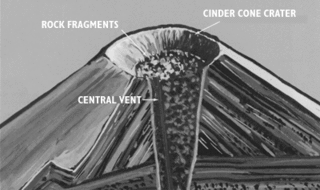
A tuya is a type of distinctive, flat-topped, steep-sided volcano formed when lava erupts through a thick glacier or ice sheet. They are somewhat rare worldwide, being confined to regions which were covered by glaciers and had active volcanism during the same period.

The Spectrum Range, formerly called the Spectrum Mountains and the Rainbow Mountains, is a subrange of the Tahltan Highland in the Stikine Country of northwestern British Columbia, 20 km west of the Stewart-Cassiar Highway, south of Mount Edziza and north of the Arctic Lake Plateau. The Spectrum Range falls within Mount Edziza Provincial Park. The range is lightly glaciated, as compared to the other ranges to the west. It is accessible only by foot or via helicopter; there are no roads to the range.
Mathews Tuya is a tuya in northcentral British Columbia. It is one of the six tuyas close to Tuya Lake. It has been partly glaciated and Ar-Ar geochronology shows that is it about 730,000 years old. It mainly comprises palagonitized tephra but also has a few dykes and jointed lava flows on its flanks. The top still has flat-lying lava flows erupted after the tephra pile grew above the surface of the enclosing lake. The other volcanoes in the area include Tuya Butte, South Tuya and Ash Mountain. The volcanoes in the region form part of the Northern Cordilleran Volcanic Province.
Sidas Cone is one of the cinder cones located north on the Mount Edziza plateau in British Columbia, Canada. Sidas Cone is visible from almost anywhere around the plateau.

Armadillo Peak is a 7.5-million-year-old caldera, located about 3 km north of Bourgeaux Creek and northeast of Raspberry Pass, British Columbia, Canada. It is south of Mount Edziza and is overlapped by the Ice Peak central volcano, which was formed during the early Pleistocene. Its caldera is largely destroyed by glaciers. It is part of the Mount Edziza volcanic complex, which is made of basaltic lava flows.

Ice Peak is a stratovolcano, located 39 km (24 mi) west of Tatogga and 3 km (2 mi) south of Mount Edziza, British Columbia, Canada. It overlaps the 7.5-million-year-old Armadillo Peak. It lies on a large volcanic plateau, which is made of basaltic lava flows from the massive Mount Edziza volcanic complex. Ice Peak last erupted during the Holocene.
Mount Somolenko is a volcanic peak in southwestern British Columbia, Canada, located 83 km (52 mi) east of Rivers Inlet and 7 km (4 mi) south of Mount Silverthrone. It is the highest peak south of Mount Silverthrone in the Ha-Iltzuk Icefield.
Mount Fitzgerald is a volcanic peak in southwestern British Columbia, Canada, located 84 km (52 mi) east of Rivers Inlet and 4 km (2 mi) east of Mount Silverthrone.
Sleet Cone is a cinder cone in northern British Columbia, Canada. It lies in the Desolation Lava Field and is thought to have last erupted in the Holocene period and is part of the Mount Edziza volcanic complex.
Storm Cone is a cinder cone in northern British Columbia, Canada. It is thought to have last erupted in the Holocene period and lies on the Desolation lava field which is part of the Mount Edziza volcanic complex.

Meszah Peak is a volcanic cone located 66 km (41 mi) north of Telegraph Creek and 136 km (85 mi) southwest of Zus Mountain in British Columbia, Canada. It is the highest peak of the Level Mountain Range, a cluster of bare peaks on the summit of the massive Level Mountain shield volcano, which forms the most voluminous and most persistent eruptive centre in the Northern Cordilleran Volcanic Province.
The Great Meteor hotspot track, also referred to as the New England hotspot track, is a vast trail of hotspot magmatism in the Northern Hemisphere. It extends over 5,800 km (3,604 mi) from Nunavut in Northern Canada to the northern Atlantic Ocean. Volcanism in the hotspot track was produced by the New England or Great Meteor hotspot, with the oldest magmatic activity dating back at least 214 million years ago during the Late Triassic period. This makes the Great Meteor track one of the oldest hotspot tracks on Earth. It contains over 80 volcanoes, with the most recognizable ones located in the Atlantic Ocean where they form seamounts.
Snippaker Creek Cone is a cinder cone of the Iskut-Unuk River Cones group in northwestern British Columbia, Canada, located near the western flank of Cinder Mountain. It last erupted during the Holocene epoch.
King Creek Cone is a subglacial mound of the Iskut-Unuk River Cones group in northwestern British Columbia, Canada. It last erupted during the Pleistocene epoch.
Source Hill is a cinder cone in northwestern British Columbia, Canada. It is polygenetic in nature, having erupted more than once throughout its eruptive history. It is one of the volcanoes in the central portion of the Mount Edziza volcanic complex and last erupted during the Pleistocene period.







